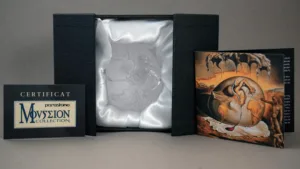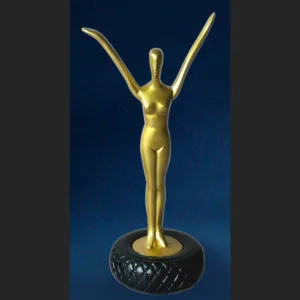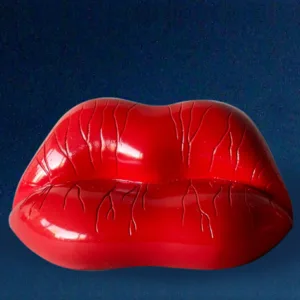The Parastone studio continuously works on new and surprising ideas and designs.
News
Symbol of birth and potential

“Geopolitical Child Watching the Birth of the New Man” is a famous painting from 1943 by Salvador Dalí. This glass artwork centers on the egg – a powerful symbol of new possibilities. The fragments of continents suggest that it is not only a personal creation, but reflects a global perspective. The breaking egg represents the instability of the old and the emergence of a new era. (SD03C – h. 6.5 cm. clear)

IN LUXURY GIFT BOX, WITH CERTIFICATE AND BROCHURE
Salvador Dalí

Deco Design sculpture OSCAR
The “golden welcoming figurines” at the Dalí Theater-Museum in Figueres are not Oscars, but gilded figures designed by Dalí (or created according to his instructions) that adorn the façade and the roof.
Many visitors refer to them as “Oscar-like” because, like the real Academy Awards, they are slender, gold-painted human figurines.
They are part of Dalí’s theatrical total design for the museum (1970–1974): a pink façade with small sandwiches (panes), gigantic eggs on the roof, and the golden figurines along the edge and around the main entrance. (SD13 – h. 17.5 cm.)
Mae West LIPS

DALÍ Saliva-sofá, c. 1974
The Mae West Lips Sofa is considered one of the most recognizable objects from the Surrealist movement and symbolizes the blurring of art into everyday objects.
The Saliva-sofa brings the world of Salvador Dalí into your interior. This iconic sofa, designed in 1937, is inspired by the full lips of actress Mae West. Dalí admired Mae for her charismatic and playful appearance. The design originates from a gouache (painting) from 1935 titled ‘Mae West’s Face which May be Used as a Surrealist Apartment’, in which Dalí transformed Mae’s face into a surreal interior – her lips became a divan. The Mae West room is one of the most popular rooms in the Dalí Theater-Museum in Figueres. (SD14 – h. 7.5 cm, w. 16 cm.)
Dubout, let’s play !

Mischievous, curious, and always up for mischief – this new Dubout cat captures everyone’s heart. With their boundless curiosity, Dubout cats sometimes get into trouble, but as always, they land gracefully on their four paws. Afterwards, they enjoy being petted and purr loudly in satisfaction for their owners. These charming figurines bring a smile to any interior and are a must-have for every cat lover.
Discover the new Dubout cat now in our collection and let us play! (DUB84 – h. 6.5 cm.)

Just looking at Dubout cats makes you happy .. !
This is Love

JACKY ZEGERS
With This is Love, Jacky tells the story of Charlie and Chris, two souls, one story. These sculptures are the tangible proof of love in all its forms. Inspired by the classic Dutch farmer and farmer’s wife, with a contemporary twist. They kiss each other in a moment of pure connection. Because true love knows no bounds, but comes from the heart.
Artist Jacky Zegers shows in her work how beautiful life can be: full of joy, love, and wonder. Her art radiates positivity and invites you to take a moment to enjoy the present – always with a playful wink. (JZ62 set bronze and JZ63 set Delft blue – h. 10,5 cm.)
Salvador Dali, also available in 47cm. version

This elephant on long legs with an obelisk on its back comes from the painting The Temptation of Saint Anthony 1946 (La Tentation de Saint Antoine). In this painting, a fascinating and ominous scene unfolds. At the center stands the figure of Saint Anthony, a Christian hermit, kneeling in deep concentration, his cross raised against a looming procession of surreal apparitions.
From the distance they approach: colossal horses and elephants, balancing on absurdly long, spindly legs that seem to carry them weightlessly through the air. (SD04 – h. 24 cm., SD12 – XL h. 47 cm.)
FORCHINO The Flight Attendant

Just as the air hostess was about to serve dinner, the aeroplane started to experience small jolts, that became increasingly severe. The food trolleys were swiftly stowed, and the turbulence got worse. Loose objects were flying through the air. Domenico felt his stomach turn, a tremor ran through his body, and he thought he was going to faint. Ten minutes later, calm was restored, and the flight stabilised. The air hostess came back with her trolley and, picking up a tray in each hand, she asked him with a friendly smile, “Chicken or pasta…?”. “A sick bag, please!” replied Domenico.. (FO85556 – h. 44 cm.)
La Ménagerie Géométrique, de Mondrian

Piet Mondriaan (1872-1944) is seen as a pioneer of abstract and non-figurative art. In 1911, he was entranced by the work of the French Cubists, moved to France and Frenchified his name to Mondrian He wrote that: ”I am of the opinion that it is possible to arrive at an artwork that is just as strong as it is true, using horizontal and vertical lines consciously constructed, but not in a calculating manner”. (sets MEG01 – MEG09, ± 6 – 4 cm., or for example coasters Ø 10 cm. set of 4 in metal holder)

The Nike of Samothrace

(c 190 BC) This iconic statue from ancient Greece is also known as the Winged Victory. It depicts the Greek goddess Nike, the personification of victory. The statue stood in the sanctuary for the Great Gods (Theoi Megaloi) on the small island of Samothrace in the Aegean Sea. The sculpture shows the goddess with her wings spread, while standing on the prow of a ship.
The right wing of the statue, as now on display in the Louvre, was later reconstructed. Originally, the statue was vividly coloured, like almost all statues of the time.
With its theatrical quality, the Nike of Samothrace has inspired countless artists over the centuries. (GRE10 – h. 27 cm., GRE11 – h. 43 cm.)
Head of bull

Wall decoration
(WU73402 – h. 38 cm.)
Ganesha and Lakshmi

Ganesha is one of the best-known and most worshippe deities in the Hindu Panteon and is the Supreme God in the Ganaptaya sect. His depictions are found throughout India. Hindu denominations worship him regardless of affiliations. Devotion to Ganesha is widely diffused. Lakshmi is the Hindu goddess of light, wealth and happiness, as well as beauty, courage, fertility and love. She is considered the mother of the universe in Hinduism and is worshipped during the annual Diwali festival of lights. (WU74301 Ganesha – h. 19 cm., WU75741 Lakshmi – h. 21 cm.)
La petite châtelaine, Camille Claudel

Between 1890 and 1893, at the height of their relationship, Claudel and Rodin stayed at the romantic castle L’Islette in the Loire valley. There Claudel portrayed the six-year old Madeleine Boyer, the castle owner’s granddaughter. In the years that followed, Claudel produced four marble versions of the portrait. The most finished version with detailed hair and a marble plinth, was made in 1896 at the behest of industrialist Henri Fontaine. The sculpture harks back to Renaissance sculpture. (CC06 bronze colour – h. 16 cm.)